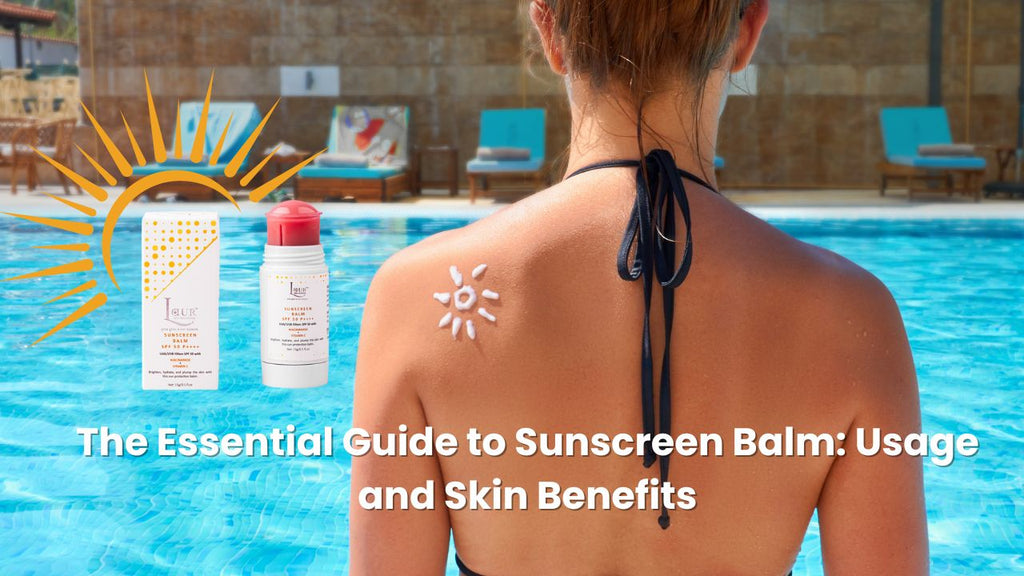The Essential Guide to Sunscreen Balm: Usage and Skin Benefits

When it comes to skincare, protecting your skin from the sun's harmful rays is paramount. Sunscreen balm is an essential product in any skincare routine, offering both protection and nourishment. This guide explores the effective uses and benefits of sunscreen balm, helping you achieve healthy and radiant skin while keeping it safe from sun damage.
Understanding Sunscreen Balm
Sunscreen balm is a protective skincare product that combines sun-blocking agents with nourishing ingredients. Unlike traditional sunscreens, the balm form provides a more concentrated and targeted application, making it ideal for sensitive areas like the face, neck, and shoulders. With a formulation designed for easy application and long-lasting protection, sunscreen balm is a versatile addition to your skincare arsenal.
Composition of Sunscreen Balm
Sunscreen balm is composed of various ingredients that provide SPF 50 P++++ protection, offering a broad spectrum defense against UVA and UVB rays. Key ingredients include:
- Caprylic/Capric Triglyceride: Derived from coconut oil and glycerin, this ingredient helps to moisturize and smooth the skin.
- Zinc Oxide: A mineral-based sunscreen agent that provides broad-spectrum protection by reflecting and scattering UV radiation.
- Octinoxate, Octisalate, and Avobenzone: Chemical sunscreen agents that absorb UV radiation and convert it into harmless heat, preventing it from penetrating the skin.
- Cetyl Alcohol: A fatty alcohol that acts as an emollient and thickening agent, providing a smooth texture.
- Butyrospermum Parkii (Shea Butter): Known for its moisturizing and anti-inflammatory properties, it helps to soothe and hydrate the skin.
- Cera Alba (Beeswax): Provides a protective barrier on the skin, locking in moisture.
- Tocopheryl Acetate (Vitamin E): An antioxidant that protects the skin from free radical damage and helps to maintain skin health.
- Niacinamide and Ascorbic Acid (Vitamin C): These vitamins help to brighten the skin, improve its texture, and provide antioxidant protection.
- Bisabolol and Allantoin: Known for their soothing and anti-irritant properties, they help to calm the skin.
- Polyhydroxystearic Acid, Silica, Iron Oxides, Triethoxycaprylylsilane, Phenoxyethanol, Ethylhexylglycerin: These ingredients ensure the product's stability, texture, and preservation.
Main Uses of Sunscreen Balm
Sunscreen balm is a multifunctional product that offers various benefits for skin health:
Protection from UV Radiation: The primary function of sunscreen balm is to protect the skin from the harmful effects of UV radiation. The combination of zinc oxide, octinoxate, octisalate, and avobenzone ensures comprehensive protection against both UVA and UVB rays.
Hydration and Nourishment: The inclusion of moisturizing ingredients like shea butter and beeswax, along with vitamins E and C, ensures that the skin remains hydrated and nourished throughout the day. This helps to prevent dryness and maintain a healthy skin barrier.
Brightening and Anti-Aging: Niacinamide and vitamin C work together to brighten the skin, reduce the appearance of dark spots, and improve overall skin tone. These ingredients also stimulate collagen production, which helps to reduce the appearance of fine lines and wrinkles.
Soothing and Calming: The presence of bisabolol and allantoin provides a soothing effect on the skin, making sunscreen balm suitable for sensitive skin types. These ingredients help to reduce redness and irritation, ensuring that the skin remains calm and comfortable.
Proper Usage Guidelines for Sunscreen Balm
To maximize the benefits of sunscreen balm, it is important to use it correctly. Here is a step-by-step guide on how to apply it:
- Cleanse: Start with a clean face. Use a gentle cleanser to remove any dirt, oil, or makeup.
- Apply: Take a small amount of sunscreen balm and apply it evenly to your face and any other exposed areas. Be sure to cover sensitive spots like the nose, ears, and neck.
- Reapply: Reapply sunscreen balm every two hours, or more frequently if you are swimming or sweating.
Safety Precautions and Potential Side Effects of Sunscreen Balm
While sunscreen balm is generally safe for most skin types, it is important to be aware of potential side effects and precautions:
Common Side Effects: Some users may experience mild irritation, redness, or a tingling sensation, especially if they have sensitive skin. If this occurs, discontinue use and consult a dermatologist.
Patch Test: Conduct a patch test before using sunscreen balm for the first time. Apply a small amount to a discrete area of your skin and wait 24 hours to check for any adverse reactions.
Choosing and Purchasing Sunscreen Balm
Selecting the right sunscreen balm is crucial for achieving the best results. Here are some tips for making an informed choice:
- Selecting the Right Balm: Choose a sunscreen balm that lists zinc oxide and other active ingredients high in the formulation. Look for additional nourishing ingredients like shea butter, vitamin E, and vitamin C to ensure that your skin receives comprehensive care.
- Safe Storage and Handling: Store sunscreen balm in a cool, dry place away from direct sunlight to maintain its effectiveness. Ensure the cap is tightly sealed after use to prevent the product from oxidizing.
- Integrating into Skincare Routine: Apply sunscreen balm as the final step in your morning skincare routine. Follow up with makeup if desired. Remember to reapply throughout the day for continuous protection.
Verdict
Sunscreen balm is an essential skincare product that offers a wide range of benefits, from protecting the skin against UV damage to providing hydration and nourishment. Its combination of sun-blocking agents and skin-loving ingredients makes it a powerful tool for maintaining healthy and radiant skin.
Start with a small amount and gradually increase as needed. Always apply a broad-spectrum sunscreen with SPF 50 P++++ for optimal protection. Consult a dermatologist to find the most suitable product for your skin type and specific concerns.
Frequently Asked Questions
How often should I use sunscreen balm?
Apply sunscreen balm every morning as part of your skincare routine and reapply every two hours or immediately after swimming or sweating.
Can sunscreen balm be used on all skin types?
Yes, but individuals with sensitive skin should conduct a patch test and choose a product formulated for sensitive skin.
What should I do if I experience irritation?
Discontinue use immediately and consult a dermatologist if irritation persists.



